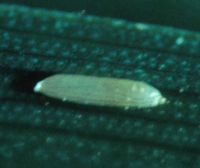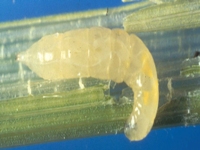|
Whorl Maggot
| Symptom of Damage : |
- Maggot feeds on the tender tissue inside the whorl
- Yellowish white longitudinal marginal blotching with hole.
- Drooping of young leaves near the tip.
- The maggots attack the leaf blades and the initial damage is characterized by the presence of narrow stripes of whitish areas in the blade margins.
- White or transparent patches.
- Presence of feeding lesions in the lines and the infested plants become stunted.
- Damaged leaves easily break from the wind
|
 |
 |
| Yellowish white marginal blotching of leaves |
Presence of maggot |
|
| Top |
| Identification of pest : |
|
Scientific Name - Hydrellia sasakii
- Egg :
White, cigar shaped egg laid singly on either side of the leaves.
- Grub :
Newly hatched larva is transparent to very light cream in colour but later become yellow. The larvae move down the leaf into the whorl. Damage can be seen as pinholes in the leaves and white and yellowish lesions on the leaf edge.
- Pupa :
Pupation takes place in between the leaf sheath where the pupa is loosely attached the stem. The puparium is light to dark brown ovoid and sub-cylindrical in shape.
- Adult : Adult dark grey flies, 1.8-2.3 mm in size.
|
 Egg Egg |
 Larva Larva |
| |
 Whorl maggot Whorl maggot |
 Whorl maggot adult Whorl maggot adult |
| |
|
| Top |
| Management Strategies : |
|
- ETL : 25% damaged leaves.
- Remove the alternate hosts and adjust the time of planting (early).
- Optimum recommendation of potash fertilizer.
- Spray fenthion 100 EC 500 ml (or) quinalphos 25 EC each at 1000 ml/ ha (or) application of Thimet 5 kgs/acre.
- The eggs are parasitized by Opius sp., Tetrastichus sp., and Trichogramma sp., and preyed upon by Dolichopus sp., Medetera sp., and Syntormon sp.
- The adults are hosts to spiders Lycosa pseudoannulata, Neoscona theisi, Ochthera brevitibialis, and Oxyopes javanus.
- Small wasps parasitized the eggs and the maggots. Dolicopodid flies prey on the eggs and ephydrid flies and spiders feed on the adults.
|
 |
 |
| Removal of alternate hosts |
Spray fenthion |
 |
|
| Wasps parasitize maggots |
|
| Top |
|


 Egg
Egg Larva
Larva Whorl maggot
Whorl maggot Whorl maggot adult
Whorl maggot adult


